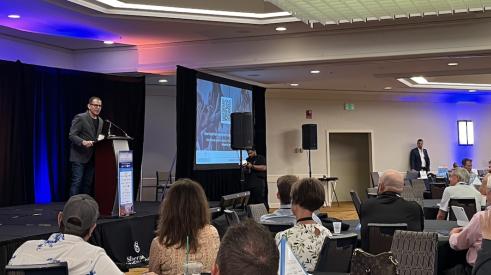I have written extensively in Professional Remodeler about the benefits of providing clients with an annual home evaluation or “check-up.” My motto is “When any project ends, the relationship is just beginning,” and my reasoning is simple: Unless you remodeled the entire home, there is always a “to-do” list. Most homeowners don’t know where to turn, and they don’t have the time or feel competent to evaluate contractors. But you already have a list of proven service providers.
The value of these annual check-ups can also be summed up with two facts: Small projects lead to bigger projects, and if you are not in regular contact with past clients, they will find someone else and forget about you.
Referral Network, Not Handyman
I recommend two service visits each year. Just like an annual doctor or dentist visit helps protect a person’s health, these check-ups protect the home. Since a home is likely a person’s biggest investment, regular check-ups make good financial sense.
The problem many remodelers have is that this sounds like a handyman business, and they don’t want to be distracted by small jobs that are not their core competence. My answer is that you can use a list of service providers to fulfill most of your client needs.
I’ve had success with this approach with a full-service design/build remodeler in Boulder, Colo. We put together a referral list for clients who needed help with a variety of projects around their house.
Over time, the list grew to include 13 referral partners: HVAC, roofing, painting, flooring, plumbing, electrical, insulation, handyman, masonry/tile, landscaping, drywall, sprinkler, and flatwork/concrete.
Ground Rules
To set this up correctly, your referral partners need to understand how the program works and agree to a few ground rules:
- Willing and able. First, they need to be willing and able to perform the service work referred from your home evaluations.
- Prompt response. Next, they need to agree to respond within 24 hours to any referral sent to them. This doesn’t mean that they have to actually show up and do the work within that time period, but they do need to make contact with the homeowner to discuss and schedule the work.
- Exceptions. The trade contractor also needs to communicate if there’s any service work that he won’t do. For example, a roofing contractor may install gutters but not clean gutters; an electrician can add an appliance circuit but probably won’t repair appliances.
- Reciprocity. Finally—and this is a big one—referral partners need to understand that the basis of this program is reciprocity. In return for referring good clients to them, you expect them to refer good clients to you.
Before making any commitments, I met with each potential referral partner at the remodeler’s office and explained all of this. It was an easy sale. Every subcontractor I met with understood the benefit of this proactive homeowner engagement.
Minimal Management
Once the referral partners understood and agreed to all of the above, I could begin to refer clients to them. When doing that, I shared the trade contractor’s information with the homeowner, and simultaneously shared the homeowner’s information with the trade contractor.
From that point on, almost no management was required, except to track what referrals were made to each of the referral partners. If no referrals were coming back from a referral partner, I learned that a simple reminder call was often enough to generate some activity.
Because homeowner referrals would be responded to quickly, I could easily double-check with the homeowner to make sure it happened. And because of the reciprocal nature of the arrangement, I didn’t worry about homeowners directly calling our partners regarding future work. Trade partners who wanted the remodeler’s work in the future would respect our relationship with the homeowner. And if the homeowner called a trade partner for additional work, we would get the referral.
This simple form of networking is one way you can begin to monetize your existing relationships with homeowners and trade partners.
The first step is to identify those in your personal and professional networks with whom you want to work. The size of this network will dictate your success. Manage these relationships and the work will follow. PR
David Lupberger has been in the remodeling industry for more than 20 years and is author of Managing the Emotional Homeowner, The Remodelers Turnkey Program, and the Home Asset Management Plan. You can reach him at david@davidlupberger.com, or at 303.442.3702.
Small projects lead to bigger projects, and staying in regular contact with past clients will ensure that you are the go-to person for that work
Add new comment
Related Stories
Brian Gottlieb Receives Remodeling Mastery Award
Presented by industry icon, Mark Richardson, the award celebrated Gottlieb’s extraordinary impact on remodeling
What's Beyond the Hammer?
Working with Brian Gottlieb on the book Beyond the Hammer provided a masterclass on how to build an aligned team
Real AI Applications For Remodelers
Tech-forward remodeler Michael Anschel shares how he uses artificial intelligence in his business.
How to Eliminate Boring, Languishing Meetings
Leff Design Build ensures maximum productivity and efficiency through these straightforward methods
5 Counterintuitive Strategies to Improve Your Business
Follow these strategies to inspire employees, instill trust, and beat the competition
Couple Act As Much More Than General Contractors
How LBR Partners uplifts and educates their Spanish-speaking trade partners
Artificial Intelligence Meets Design
An architect looks at the pitfalls of using technology to take over human design tasks
How to Correctly Hire for Business Growth
Refloor CEO Brian Elias shares exactly how his company hires the correct people for the correct seats
Managing Business Risk to Embrace Risk
As remodelers, our product is risk. Yet within our businesses, we fear risk. Just like with your projects, if you plan accordingly, your risk comes with reward
What the Most Successful Remodelers are Doing Right Now
Industry advisor Mark Richardson shares the answers to his three most asked questions: What's the remodeling market like? What are other remodelers doing? How do I measure up?













